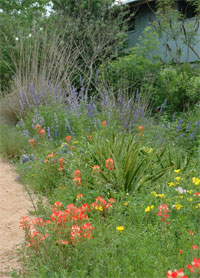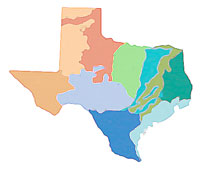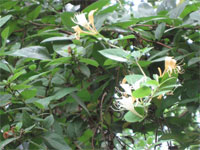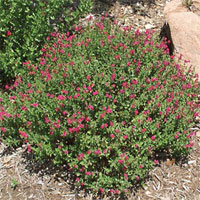Wild About Texas – January, 2010

Native plant garden at the Wildflower Center. Winecup, phlox (P. pilosa), twist-leaf yucca, and prairie beardstongue (Penstemon cobaea) mixed with mealy blue sage. Photo by Andrea DeLong-Amaya.
What Is a Native Plant?

Native plant garden at the Lady Bird Johnson Wildflower Center. From foreground to back shows: Indian paintbrush, twist-leaf yucca, mealy blue sage, and Lindheimer’s muhly. Photo by Andrea DeLong-Amaya.

Texas is large with many different vegetational zones.

Invasive Japanese (Hall’s) honeysuckle. Photo from Texasinvasives.org.

Adapted but not native pink skullcap (Scutellaria suffrutescens). Photo from Wildflower Center archives.
Periodically I get the question: “How long does a plant have to be here to be considered native? I have species roses from my grandfather, do they count?” The short answer is no, but read on for more explanation. Even though we use the phrase “native plant” all the time, the intent is often muddied. The shorthand we use here at the Wildflower Center is a plant that occurs naturally where it evolved without human introduction (without human introduction either intentionally, as a garden plant, for instance, or accidentally, as a seed stuck to a shoelace). I say “shorthand” because this isn’t a simple thing to define.
Your grandfather’s roses may be well adapted and thriving, but they were brought in by people — “assisted migration,” if-you-will — and their tenure here has been more in the tens of years rather than the hundreds or thousands it takes for significant evolution to occur. In the United States, we commonly accept native plants as those that were here prior to European colonization. But digging a bit deeper, there is a gray area when it comes to plants that may have been moved around by early Americans.* Osage orange, chile pequin, and Agave americana are some of the rare examples that fall into this category. Most of us tend to broadly embrace these as natives, even though they are likely here via the human hand. That categorization may seem somewhat arbitrary — perhaps it is, and some purists don’t agree.
Another critical element of the definition of native relates to geography. Native to where? How narrow are your parameters? Do you want plants that are native to Texas? North America? The planet Earth? The Pineywoods? Your local watershed? If you visit a garden center and ask what natives they vend, you may find something like Joe Pye weed, which is native to the U.S., but not necessarily appropriate for your garden in Kingsville. Even species from one part of the state are not necessarily fitting for another. You wouldn’t plant a Southern magnolia in Terlingua, would you? Assuming you want natives because they are better adapted than non-natives, because you are trying to preserve regional identity, and because you wish to attract native wildlife, generally speaking, the closer the range, the better.
The next issue to tackle is what a native plant isn’t. Early in my career I erroneously assumed that nandina and tallow trees were indigenous because they were growing wild. Only later did I come to understand that they are non-natives that have escaped cultivation and become noxious, displacing native vegetation and ultimately many of the native birds, insects, and other animals that rely on them. Such exotic fruit producers may feed mockingbirds or other species; however, there are many other worthy animals being deprived of the less common plants they depend on.
Pink skullcap, ‘Indigo Spires’ salvia, and ‘Pride of Barbados’ bird of paradise are examples of fine exotic plants that are adapted, well-behaved and commonly used in water-thrifty landscapes. These are often regarded as Texas natives, but alas, they are from other nations.
The more important question may not be whether or not a plant is native, but rather what are your goals? Is water conservation paramount? Did you lose plants during extreme conditions last summer or this past winter? Are you trying to avoid introducing invasive species into our environment? Is your aim to preserve our natural heritage? Will you provide food for wildlife beyond the urban “trash” species like grackles, house sparrows, and opossums? The answers to these questions will help you decide if you want to use natives exclusively, predominantly, or as supplements in your garden.
FOOTNOTE:
*Whereas prehistoric human contributions occurred infrequently over long periods of time, modern day introductions are happening at historically unprecedented rates, too fast for native ecosystems to adapt, leading to the extinction of native flora and creating unstable conditions.
For more information about Texas native plants, visit the Wildflower Center’s website at: www.wildflower.org.
About the author: Andrea DeLong-Amaya is the director of horticulture at the Lady Bird Johnson Wildflower Center in Austin.

